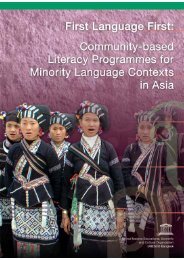Part II.pdf - MTB-MLE Network
Part II.pdf - MTB-MLE Network
Part II.pdf - MTB-MLE Network
Create successful ePaper yourself
Turn your PDF publications into a flip-book with our unique Google optimized e-Paper software.
Contact with local stakeholders<br />
The team visited and communicated with local stakeholders of indigenous communities living in<br />
different parts of the region. The study and research was carried out with the direct help of the<br />
local community leaders.<br />
Reading and review secondary sources<br />
The team successfully developed materials for the intended curriculum through reading and reviewing<br />
available information and resource books obtained from several sources. A survey report of ‘Dip<br />
Shikha’ and writings from chief researcher Dr. M.A. Jalil’s ‘Uraon,’ a research-based information<br />
bank, proved invaluable for this exercise.<br />
Field Exploration<br />
The team selected the best possible way to approach fieldwork among the communities. Although<br />
it initially encountered some constraints and threats at the local level, the team eventually successfully<br />
carried out the fieldwork.<br />
Orientation and training for the field team<br />
Training sessions were conducted for the field team. The Chief Researcher conducted the training<br />
to familiarize the team with methods and tools, rapport-building skills and analytical skills. These<br />
issues are critical for effective research work.<br />
Collecting Oraon language data<br />
During the secondary source appraisal, members of the tribal community expressed certain important<br />
concerns. In light of the appraisal, the study team surveyed different categories and levels of speakers<br />
in isolated Oraon villages from different Northwest districts, i.e. Pabna, Sirajgonj, Natore, Chapai<br />
Nowabgonj, Naogaon, Joypurhat, Dinajpur, Rangpur, Nilphamari and Thakurgaon. At the same<br />
time, a number of group discussions with Oraon people were held in different places.<br />
Inputs from the key-informants<br />
To ensure community participation and get genuine information, the research team identified some<br />
potential key informants from different parts of the region: Gonesh Kha Kha and Utpal Minji<br />
(Rangpur), Jogendra Nath Toppo and Ruhiny Kanta Ekka (Sirajgonj), Dr. Modan Kumar Barowar<br />
(Niamotpur), Sugrib Kumar Sarder and Usha Rani Lakra (Gomostapur), and Sumitra Lakra (Porsha).<br />
These resource people were very helpful by providing relevant information and by assisting directly<br />
in developing relevant materials.<br />
Data collection on culture and language<br />
In order to reflect the culture, language, and heritage of the tribe in the curriculum, the research<br />
team collected representative samples on vocabulary/dialects used among the Oraon communities<br />
147
















